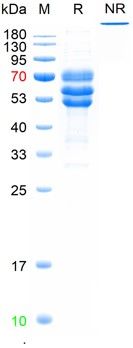Human Fibrinogen (from plasma)
人纤维蛋白原(进口)
| 英文名称 | Human Fibrinogen (from plasma) |
| 中文名称 | 人纤维蛋白原(进口) |
| 别 名 | Factor I; FGA; FGA protein; FGB; FGG; Fib2; Fibrinogen A alpha polypeptide; Fibrinogen A alpha polypeptide chain; Fibrinogen alpha chain; Fibrinogen B alpha polypeptide; Fibrinogen beta chain; Fibrinogen G alpha polypeptide; Fibrinogen gamma chain; MGC104327; MGC119422; MGC119423; MGC119425; MGC120405; FIBRINOGEN, HUMAN TYPE I FROM HUMAN PLAS; Fibrinogen from human plasma (Native) 纤维蛋白原 来源于人类血浆; |
 |
Specific References (1) | bs-1240P has been referenced in 1 publications.
111 [IF=3.55] Huang, Mo, et al. "Solidified liquid layer model makes quartz crystal microbalance a convenient molecular ruler." Colloids and Surfaces B: Biointerfaces 85.1 (2011): 92-96. Other ;
|
| 性 状 | lyophilized powder |
| 物 种 | Human |
| 序 列 | Purified native protein |
| 纯 度 | 50-70% protein basis (biuret) |
| 内毒素 | Not analyzed |
| 活性 | Yes |
| 保存条件 | Stored at -70℃ or -20℃. Avoid repeated freeze/thaw cycles. |
| 注意事项 | This product as supplied is intended for research use only, not for use in human, therapeutic or diagnostic applications. |
| 产品介绍 | Fibrinogen is the main protein of blood coagulation system. It is a large protein and it consists of two identical subunits that contain three polypeptide chains: alpha, beta and gamma. All chains are connected with each other by a number of disulfide bonds. Fibrinopeptides A (1 to 16 amino acids) and B (1 to 17 amino acids) are released by thrombin from the N terminal parts of alpha and beta chains, respectively. In this way fibrinogen is converted into fibrin, which by means of polymerization forms a fibrin clot. Fibrinogen clotting underlies pathogenesis of MI, thromboembolism and thromboses of arteries and veins, since fibrin is the main substrate for thrombus formation. Fibrinogen activation is also involved in pathogenesis of inflammation, tumor growth and many other diseases. The normal fibrinogen concentration in plasma is about 3 mg/ml. The elevated level of fibrinogen in patient's blood is regarded as an independent risk factor for cardiovascular diseases. An increase in blood fibrinogen concentration was shown to be a strong predictor of coronary heart disease (Sonel A. et al, and Rapold H.J. et al). All these facts make fibrinogen an important parameter in the diagnosis of cardiovascular diseases. 基本信息: CAS:9001-32-5 MDL:MFCD00131060分子量:α-chain 63.5 kDa; β-chain 56 kDa;γ chain 47 kDa; soluble dimer 340 kDa; 来源:human plasma(源材料均已通过HIV和HBsAg的阴性测试。) 蛋白质量:50-70% protein basis (biuret)(≥80%蛋白质可凝固) 性状:冻干粉(含~15%的柠檬酸钠和~25%的氯化钠) 溶解性:0.9% NaCl: soluble 10 mg/mL 产品简介: 纤维蛋白原(Fibrinogen),或因子I,是一种血液蛋白,参与凝血并被凝血酶转化为纤维蛋白。纤维蛋白原的分子量约为340kDa。 生化/生理作用:纤维蛋白原(Fibrinogen)是一种急性期蛋白,是蛋白质凝血级联反应的一部分。级联反应的最终结果是产生了将纤维蛋白原转化为纤维蛋白的凝血酶。凝血酶蛋白迅速水解纤维蛋白原,释放纤维蛋白肽A。这种小肽的丢失不足以使产生的纤维蛋白分子不溶解,但它倾向于与相邻的纤维蛋白和纤维蛋白原分子形成复合物。 然后凝血酶从纤维蛋白中裂解出第二种肽纤维蛋白肽B,然后形成的纤维蛋白单体自发聚合形成不溶性凝胶。聚合的纤维蛋白通过非共价键和静电力保持在一起,并被转酰胺酶,XIIIa因子稳定,XIIIa因子是凝血酶作用于XIII因子而产生的。然后不溶性纤维蛋白聚集体(凝块)和聚集的血小板阻塞受损的血管并防止进一步出血。血浆中纤维蛋白原的量可作为体内是否存在炎症过程的非特异性指标。来自任何哺乳动物来源的纤维蛋白原将被来自任何哺乳动物来源的凝血酶切割。 重构: 溶解纤维蛋白原的最佳方式就是将之置于温热的(37ºC)生理盐水上,因为纤维蛋白原不溶于水。 生理盐水的浓度可在0.85至0.9%范围内。 纤维蛋白原盐水溶液可以轻轻搅拌,但不能漩涡。 纤维蛋白原会慢慢溶解,形成一种雾状的溶液。 纤维蛋白原可经过过滤灭菌,但不能采用0.1μ的过滤器。 纤维蛋白原会慢慢溶解,形成一种雾状的溶液。 不可采用真空过滤,因为过滤过程将导致分子的破坏。
|
| 产品图片 |
本产品仅供科研使用.请勿用于医药,不能用于临床治疗诊断使用!

